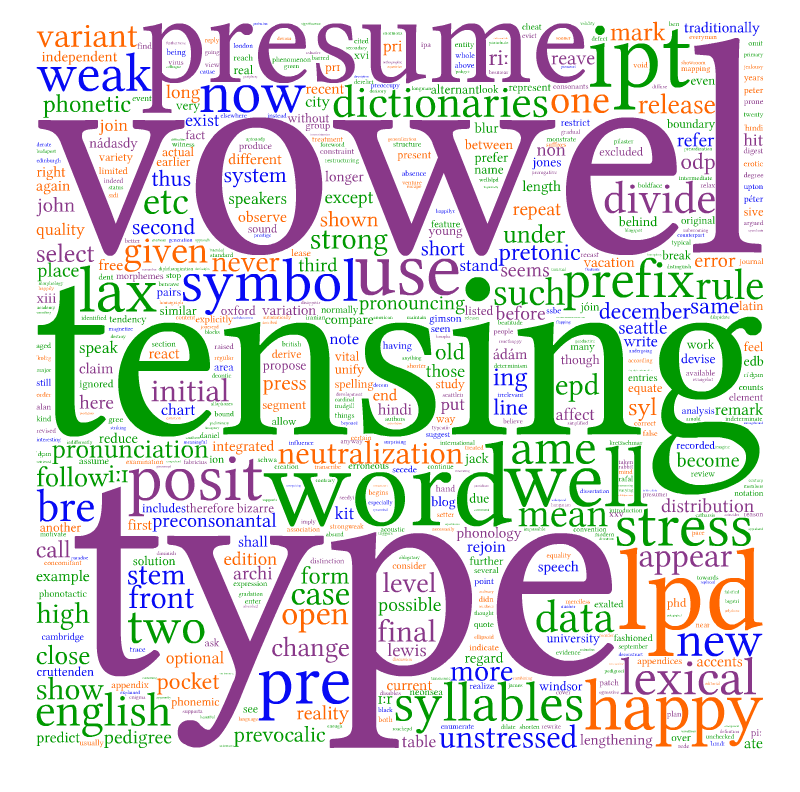
This study☞I am grateful to Péter Szigetvári for calling my attention to this development. deals with a recent development in the pronunciation of Standard Southern British English (SSBE or RP), as observed and recorded by John Wells in the third edition of his Longman Pronunciation Dictionary (LPD3, 2008). The high front vowel in initial pretonic open syllables like presume, release, December is given with /ri
Let us quote what Wells says in the Foreword to the third edition:
The expression “when unstressed” excludes independent prefixes (meaningful productive morphemes added at word level), such as de#magnetize, re#write, as well as integrated prefixes (meaningless unproductive morphemes present at lexical level, usually attached to bound stems) if they become stressed due to some stress assignment rule, e.g., dé+monstrate, rè+pre+sent (Nádasdy 1994, 2006). Our examination, then, refers to unstressed integrated prefixes. The table in (2) presents some relevant data from LPD3. Only preconsonantal data are listed, since in prevocalic position (as in react) the rule of happy-tensing produces /i/ anyway. The words listed are all given with /ə/ as a second possibility (which actually counts as third, since the notation /i/ includes the variant /ɪ/).
| be- | de- | e- | pre- | re- | se- | |
|---|---|---|---|---|---|---|
| __CV | because beyond believe | December decide determine | enamel enormous emancipate | prefer presume preliminary | release rejoice respond | |
| __.CC | begrudge bestrew between | decline (v) destroy | equality equate | prescribe preclude | refresh respond restrict | |
| __RV | bereave | derive derange derogatory | prerogative | — |
All dictionaries have inconsistencies, and the LPD3, excellent as it is, is no exception. In the Foreword (quoted above) Wells includes se- among those to be given with /i/, but in the body of the dictionary there is no trace of this: all se- words continue to appear with /sɪ-/ or /sə-/ (with the regular exception of Seattle /si-/, where the prevocalic position triggers happy-tensing). In the “Language Panel” on Weak vowels (2008: 892) Wells illustrates /i/ with only the word happy, while seductive is given with /ɪ/; here remember is also given with /ɪ/ only, though in the dictionary it is /i/ (/ə/). In a review of LPD3, Windsor Lewis writes: “Among the changes to LPD are some to words with the prefixes be
The short /i/ symbol was introduced by Wells in LPD1 (1990). The notation /i/ means, in his definition, that /i:/ and /ɪ/ are equally possible in the given place. He named the phenomenon happy-tensing in Accents of English (1982). This name, aptly, does not say “lengthening”, as the change means the raising and fronting (= tensing) of the vowel so that it will approach, or reach, cardinal [i] — but not necessarily a lengthening to [iː]. The following comment from Wells supports this, as he speaks of a tense /i/, not a long /iː/.
In the Introduction to the 14th edition of Everyman’s Pronouncing Dictionary (EPD14), Gimson remarked: “There is a tendency among young RP speakers to use a closer variant, near to the quality of /iː/, in a final position, e.g., in a word such as ‘happy’” (Jones 1977: xvi). When these authors refer to /iː/ as the new variant, they apparently mean an [i] quality, not an [iː] length, but since they work in the taxonomic tradition, they feel it necessary to refer to existing English phonemes, members of the segment inventory: this is why they mention “the quality of /iː/” — which does not mean that the happy-vowel is long. By the end of the twentieth century the tense vowel had made its way into RP. The young speakers of 1977 have now become middle-aged, and the /ɪ/ variant now counts as old-fashioned, as stated by Trudgill: “there is now some evidence that happy-tensing is, or at least is going to be, a feature of RP. […] happy-tensing will now no longer be a regional feature, though absence of happy-tensing will be” (2002: 175).
Sometimes the authors cited speak of /i/ as a neutralization of /ɪ/ and /iː/. It is possible in phonology to use a third symbol (an “archi-symbol”) to show that two segments are neutralized in a given position. It seems that originally Wells intended /i/ as such a symbol, to mean “either /ɪ/ or /i:/”. An archi-symbol has no pronunciation; it is a descriptive abbreviation, the expression of a generalization, and cannot be thought of as a phonetic symbol. We may, for example, use the archi-symbol /N/ for pre-stop nasals, expressing the neutralization of /n/, /m/, /ŋ/ in such position (hiNt, nuNber, iNk). But we could not say that “the symbol /N/ is neither /n/ nor /m/ nor /ŋ/ but a quality different from all these”. Now, it seems that /i/ — at least today — is not an archi-symbol but a true phonetic symbol, representing the sound [i], because that is what most RP speakers say. In other words, /i/ is not (or not any longer) a neutralization symbol but a proper phonetic symbol. Observe that Wells calls it “a tense vowel like /iː/”:
When explaining neutralization in another section of LPD3, Wells repeats his claim that the symbol /i/ (like its counterpart /u/) is used in LPD to explicitly symbolize one type of neutralization: that between /iː/ green and /ɪ/ grin in non-preconsonantal positions (2008: 539). He goes on to say: “In these positions the vowel is traditionally identified with /ɪ/. But in fact some speakers use /ɪ/, some use /iː/, some use something intermediate or indeterminate, and some fluctuate between the two possibilities” (ibid.). This amounts to recognizing that /i/ is a phonetic entity, a short, tense, close front vowel. Its shortness naturally follows from its unstressed position; any lengthening that may affect it is irrelevant, since length is only a concomitant feature of certain English vowels. Actually, Wells’s treatment of /i/ is similar to that of /ə/. English /ə/ is a real phonetic entity, [ə], with its place of articulation shown in the vowel trapeze (LPD3: xxv) as an ellipsoid patch in the central area. Similarly, /i/ appears as another ellipsoid patch in the high front area. This also suggests that /i/ is not an abbreviatory convention but a vowel.
In a section entitled ‘Changes Well-established’, Cruttenden speaks about “Final /ɪ/ replaced by /iː/ in words like city. […] Recent editions of pronouncing dictionaries transcribe this with /i/ without the length marks, presumably to indicate that this final unaccented /i/ is often shorter than /iː/ elsewhere. […] In a phonemic analysis this final vowel could be ascribed either to /iː/ or to /ɪ/ or regarded as a neutralized form” (2001: 82).
Let us compare the strategy of some pronouncing dictionaries concerning /i/ and similar vowels. Cruttenden remarks, “The latest editions of standard pronouncing dictionaries transcribe [final unaccented vowels like city] with [i] and thus avoid equating it either with /ɪ/ or /iː/” (2001: 107). Interestingly, the ODP (Upton et al. 2001), which is the most radically innovating of the current pronouncing dictionaries (witness its treatment of AmE flapping as underlying /d/, so city /sɪdi/) does not indicate presume-tensing: it uses /ɪ/ in all such cases.
| Jones EPD13 1967 | Gimson EPD14 1977 | W.Lewis WL 1972 | Upton ODP 2001 | Roach EPD16 2003 | Wells LPD3 2008 | |
|---|---|---|---|---|---|---|
| city | ||||||
| seedy | ||||||
| bigotry | ||||||
| Hindi | ||||||
| pedigree | ||||||
| Seattle | ||||||
| reality | ||||||
| presume | ||||||
| December |
The table shows that when the vowel is strong (i.e., there is some stress), /iː/ and /i/ are not neutralized but continue to contrast. Consider pedigree /ˈpedɪgriː/, where only /-iː/ is given in all sources. This word has a 103 stress structure, like parachute /ˈpærəʃuːt/ or Levantine /ˈlevəntiːn/, so the syllable
The change under examination, from /ɪ/ to /i/ in release, presume, December, is, then, a case of tensing. Its phonetic content is the same as that of happy-tensing; however, it is now extended to preconsonantal positions. In the earlier system /i/ and /ɪ/ were in complementary distribution in weak syllables, so /i/ could be regarded as an allophone of weak /ɪ/, as shown by the dotted line in (6).
| strong | weak | ||||
|---|---|---|---|---|---|
| /iː/ | /ɪ/ | /ɪ/ | /i/ | ||
| preconsonantal | __C | heat | hit | rabbit | — |
| non-preconsonantal | __V __# | neon sea | — | — | react happy |
If Wells’s new data are right — and we assume this to be the case — this means a restructuring of the system, since now /i/ appears before consonants as well (release, presume, December), so its distribution overlaps with that of /ɪ/: the two are no longer allophones. There are quasi-minimal pairs like divide /dɪ-/ vs. devise /di-/. The new system of LPD3 looks like this:
| strong | weak | ||||
|---|---|---|---|---|---|
| /iː/ | /ɪ/ | /ɪ/ | /i/ | ||
| preconsonantal | __C | heat | hit | rabbit | presume |
| non-preconsonantal | __V __# | neon sea | — | — | react happy |
The appearance of preconsonantal /i/ is still very restricted: it appears only in syllables that are (or look like) morphemes, namely the integrated prefixes be
It is important that be
The new /i/ pronunciation of the unstressed integrated prefixes may lead to the blurring of the integrated/independent distinction. Compare LPD3’s two entries for rejoin:
Normally, in (9b) the stress (and the concomitant length) will mark the prefix as independent and meaningful. But in the new system the vowel quality in (9a) is the same, and given faster speech and Rhythmic Stress-Deletion, re+ and re# may well become homophonous, as in didn’t rejoin. This homophony, however, does not point towards the independent prefixes “sinking” to the integrated level; on the contrary, it seems that the integrated prefixes are “rising” to the independent level, as their vowel is no longer sensitive to the following segment. Such an arrangement would suggest a “strong” (or word) boundary, so be#reave, etc. But this is falsified by the bound stem -reave. We thus witness a false re-morphologization of these prefixes, a re-analysis of “prefix+stem” to “prefix#stem”.
In the new system a tense vowel, /i/, can freely appear before /r/ without Pre-R Breaking (i.e., laxing and/or diphthongization with an /ə/-offglide) taking place, e.g., bereave, derive. This can be explained in two ways. We might posit a strong boundary between prefix and stem, thus be#reave, de#rive. As Pre-R Breaking is a word-level rule, the strong boundary disables it, just like in keyring, showroom, etc. This solution would work from the phonological point of view, but cause difficulties in the morphology: only a free stem can stand after the # boundary, as in de#magnetize, re#write, pre#existence. If we blur the distinction between, say, pre+sume and pre#set, we shall not be able to distinguish re+join from re#join, or re+creation
The other possibility is to relax the phonotactic constraint that high vowels cannot stand before /r/, and maintain its validity only in strong (= stressed) syllables. Accordingly, hero cannot be /-iːr-/ and must be /
Unstressed open syllables are generally weak in English, e.g., lemonade, jealousy, evidence, polythene, Paradise. However, in word-initial syllables (which a fortiori must be followed by a major-stressed syllable, since no word begins with two unstressed syllables) an unstressed syllable may be “strengthened”, that is, it may have its full (or “strong”) pronunciation, which is normally a tense (long or diphthongal) quality since the syllable is open (unchecked): director /aɪ/, vacation /eɪ/, etc. This initial-pretonic tensing is not a predictable regularity: there are lexical exceptions to it, where only /ə/ is given: propose, domestic, variety, Jamaica, etc. The tensing tendency is restricted to syllables which are both pretonic and open: a recent acoustic study has shown that in -ES and -ED suffixes, that is, typical posttonic closed weak syllables with /ɪ/, there is no sign of change in the speech of young RP speakers (Fabricius 2002). Observe the varying degree and incidence of Initial-Pretonic Tensing in the examples in appendix 2.
Initial-pretonic tensing is more widespread in American English. For example, pilaster with /paɪ-/ is only recorded for AmE, and probation /prəʊ
| Upton ODP 2001 | Roach EPD16 2003 | Wells LPD3 2008 | ||||
|---|---|---|---|---|---|---|
| BrE | AmE | BrE | AmE | BrE | AmE | |
| presume | ɪ (ə) | i (ə) | ɪ (ə) | ɪ (iː) | i (ə) | i (ə) |
| December | ɪ (ə) | ə (i) | ɪ (ə) | ɪ | i (ə) | i (ə) |
| release | ɪ (ə) | ə (i) | ɪ (ə) | ɪ (ə) | i (ə) | i (ə) |
| re#lease | iː | i | — | — | — | — |
As can be seen, the ODP, which never marks presume-tensing for BrE, does so for AmE, using the very same symbol /i/ in presume (first variant), December and release (second variant) as for the independent prefix in re#lease. EPD16 has /iː/ as a second alternant in presume, and no /ə/ alternant for December. This shows that AmE has indeed further progressed in Initial-Pretonic Tensing.
The table in (11) shows that in BrE a gradual tensing tendency is observable, which began with prevocalic /ɪ/ (type D), then spread to final /ɪ/ (type E, happy-tensing), and has now reached preconsonantal /ɪ/ in some types of words (type F, presume-tensing). Type S is a strong-vowelled (= stressed) open syllable. In (11) the shaded boxes are the pronunciations given in LPD3. (We present further examples in the appendices.) The symbol 0 means “phonotactically excluded” (since prevocalic schwa is impossible in English).
| lax ↔ tense | |||||
|---|---|---|---|---|---|
| type | ə | ɪ | i | iː | |
| pedigree | S | ||||
| propose, variety, support | A | ||||
| pocket, -ing, -ed | B | ||||
| divide, select, pedigree, happily | C | ||||
| reality, Seattle, preoccupy | D | 0 | |||
| happy, happiness, polytechnic | E | ||||
| presume, release, December | F | ||||
We may tabulate the same distribution in the following chart:

Since not every traditional /ɪ/ is subject to the phenomenon of presume-tensing, we must ask what conditions it. The environments (see more data in the appendices) show only two things. First, in prevocalic position /i/ is obligatory by happy-tensing, so /i/ is found in words like beatitude, deontic, react, reality, Seattle. Second, /i/ does not appear in a closed syllable (i.e., it may not be followed by two consonants that are not an onset), e.g., exalted /ɪ/ (/ə, e/), September /e/ (/ɪ, ə/). The remaining cases where the vowel is in a weak open preconsonantal position, are not predictable (i.e., types B, C, F). Wells himself says: “As far as I know, no one uses a tense vowel in bizarre, whereas in behind and other be- words some people do” (Wells 2012). Compare these data from LPD3:
| earlier | new | type | |
|---|---|---|---|
| presume, devise, behind | ɪ (ə) | i (ə) | F |
| divide, select, bizarre | ɪ (ə) = | ɪ (ə) | C |
How can we distinguish presume, devise, behind, which show presume-tensing (type F) from divide, select, bizarre, which do not (type C)? A solution would be to assume that presume and divide have different lexical (= underlying) segments in their first nucleus, which are mapped unto different surface interpretations (= pronunciations). This would imply that the lexicon of RP has been restructured; type F words have and underlying tense vowel /i/ (which may be laxed to /ɪ/, or even to /ə/), but type C words have an underlying lax vowel /ɪ/ (which may be further laxed to /ə/ but not tensed to /i/).
We may regard the optional lengthening of /i/ to /iː/ as a free variant, predictably available in all cases. Therefore we repeat the chart, ignoring those lines as optional and predictable:
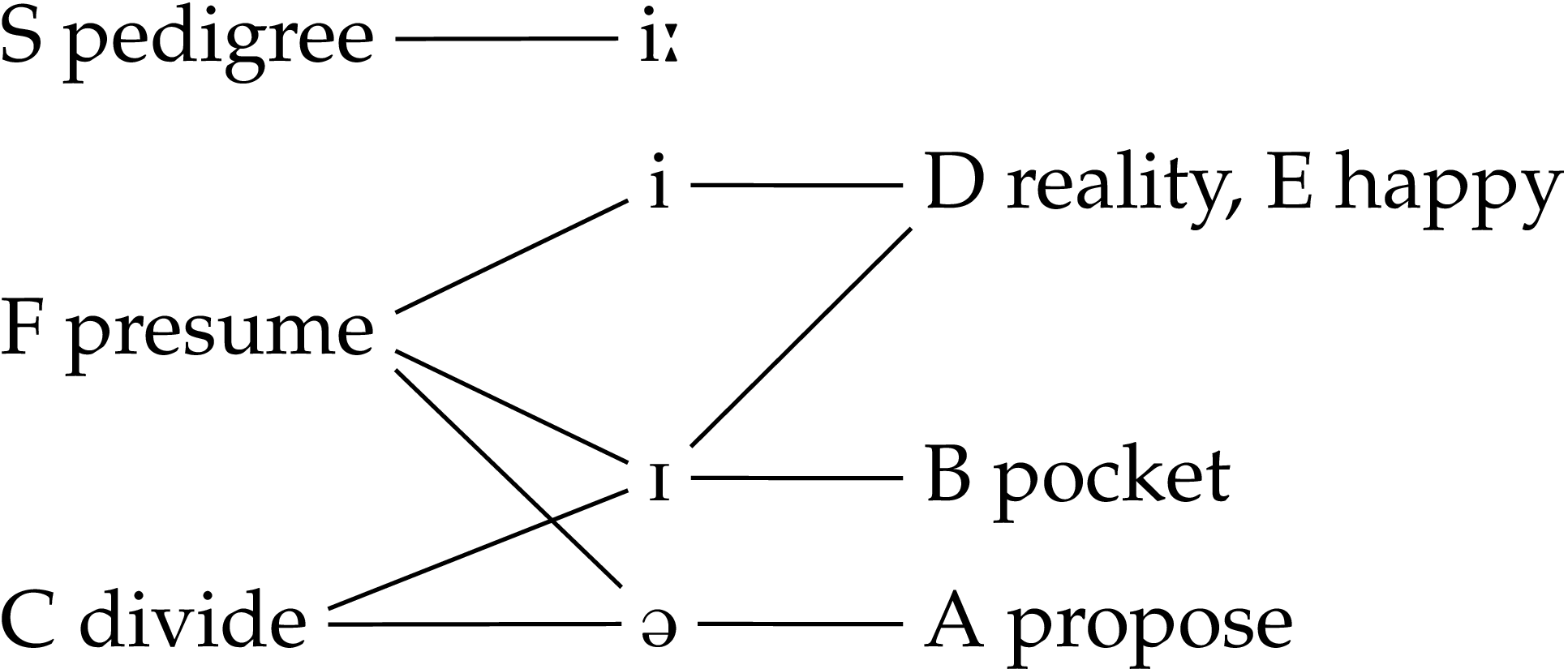
The sound /i/ can — in conservative speech — be pronounced as /ɪ/ in all positions. We regard this as an optional laxing rule, available in all cases. Therefore we repeat the chart without those lines:
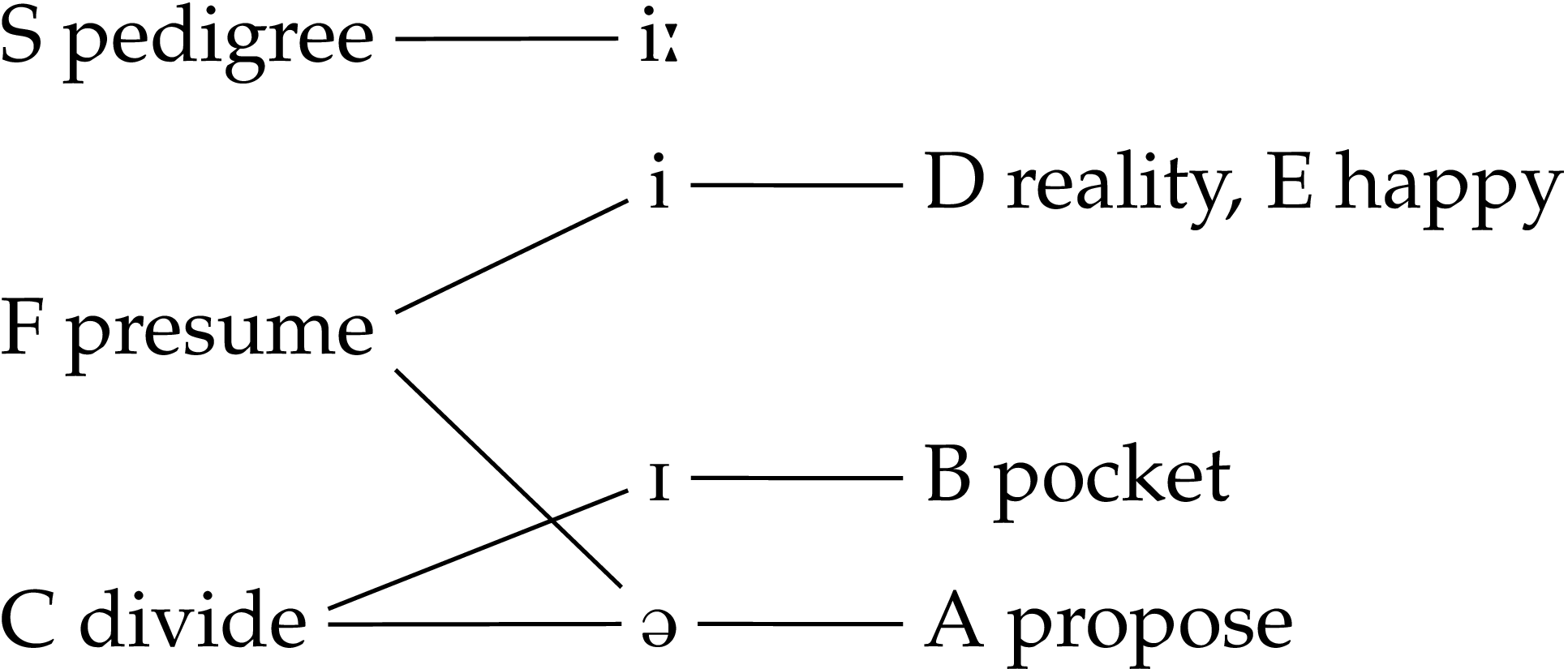
Prevocalic /i/ is barred from becoming /ə/ by the phonotactic constraint of Prevocalic Tenseness. Therefore we may put type D under type F, marking it with an asterisk to show its limited distribution:
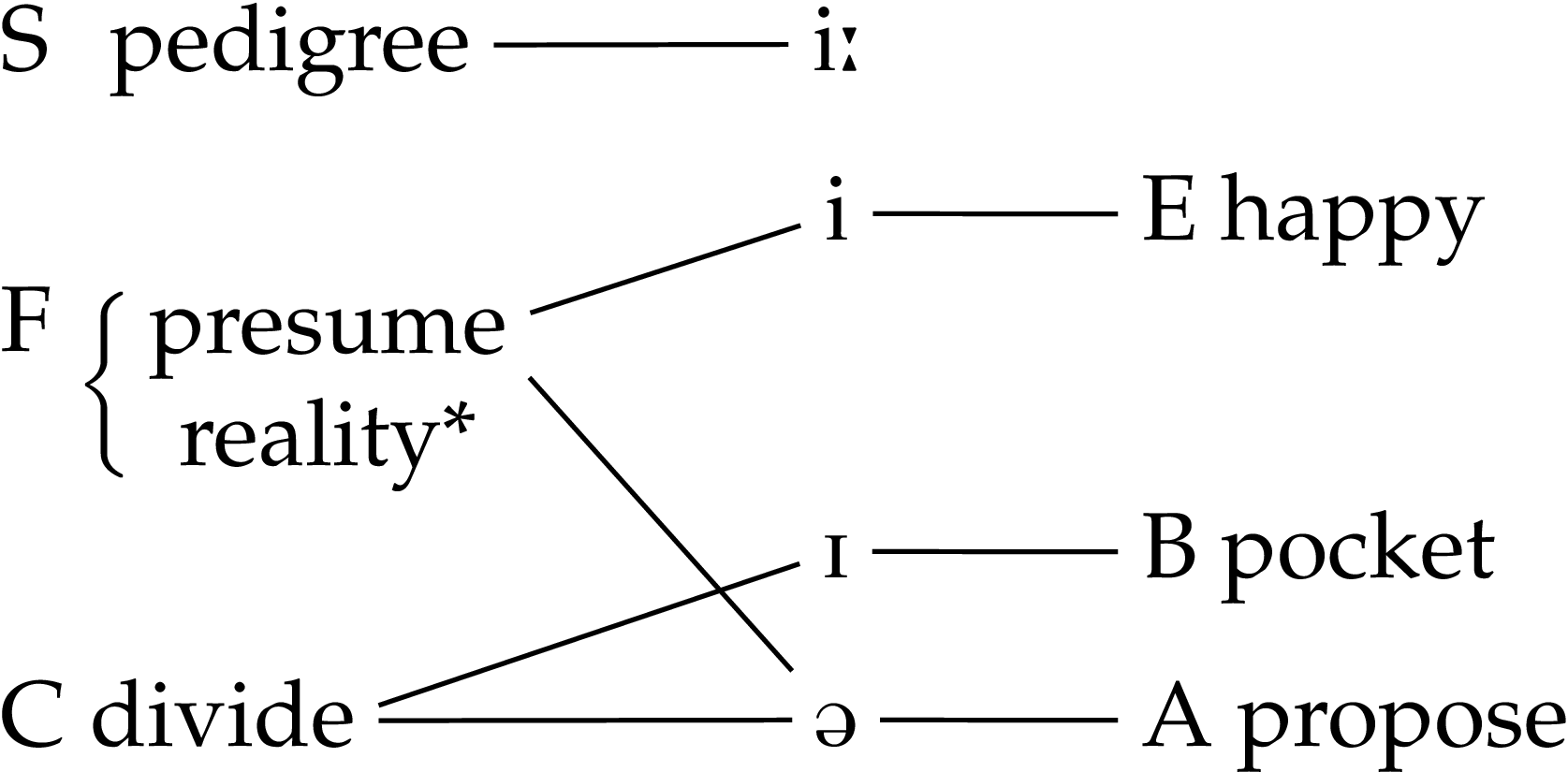
Let us realize that type E, happy, is not the neutralization of anything: it has /i/ with its optional variant forms /iː/ and /ɪ/. We may unify it with type F, presume, except that now we have to stipulate that /i/ can never become /ə/ before #. (Counterexamples like happily, merciless, beautiful, which have /ɪ/ or /ə/, are irregular and must be treated as undergoing stem change to type C. Hindi, on the other hand, has two lexical forms: one of type E, one of type S.) We repeat our chart, putting type E with F, and marking it with ** to show its limited distribution:
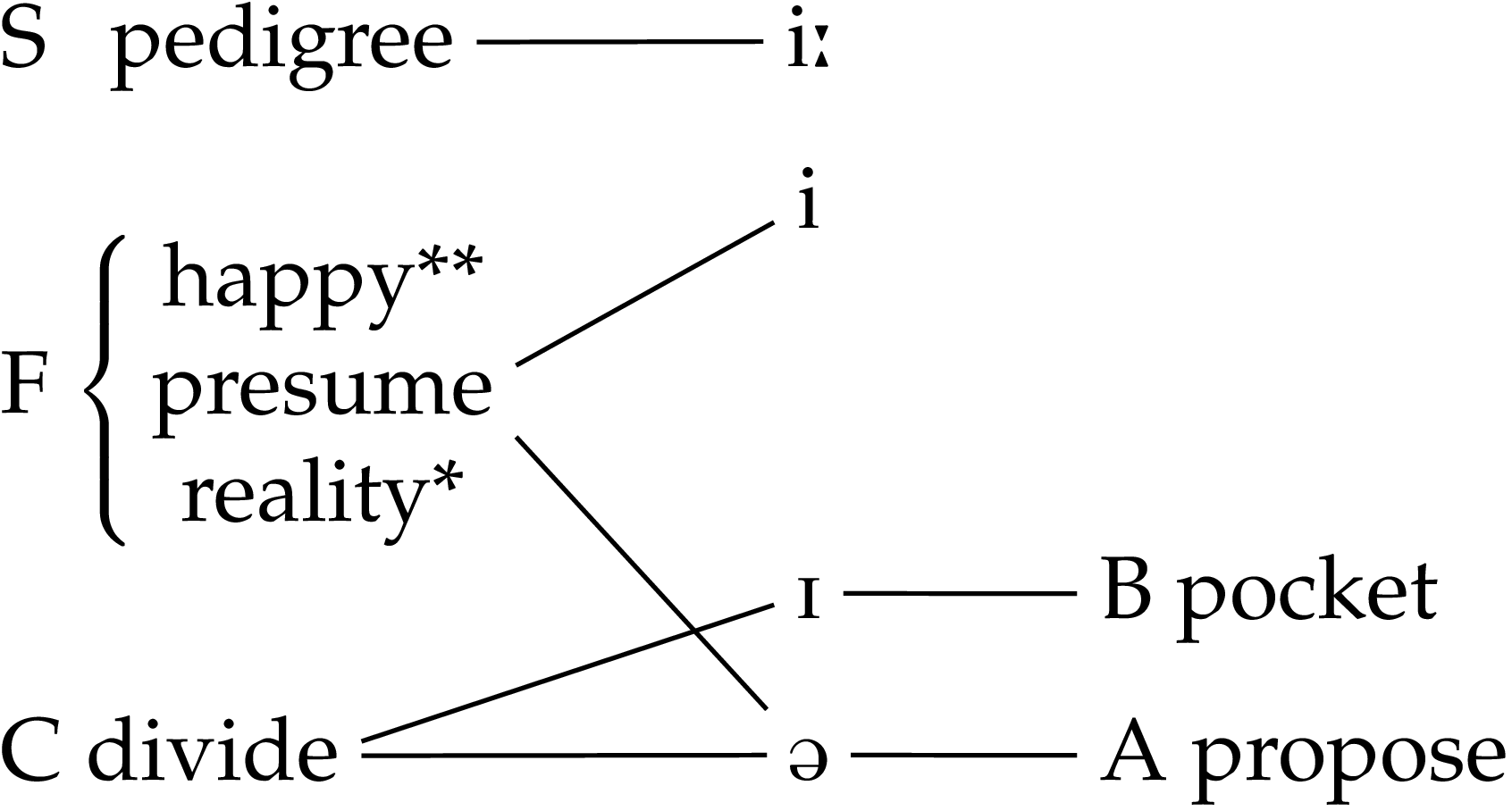
Now we may claim that lexical /i/ can optionally be reduced to /ə/ except when a rule blocks this reduction. With this in mind, type S, pedigree, may also be unified with type F, since type S, being strong or stressed, will never shorten in an open syllable and never reduce to /ə/. We may unify it with F, all these words having lexical /iː/. Rather than allowing for a lengthening of underlying /i/, we shall allow for a shortening of underlying /iː/ in weak positions. We mark pedigree with *** to show that it never reduces due to its strong position:
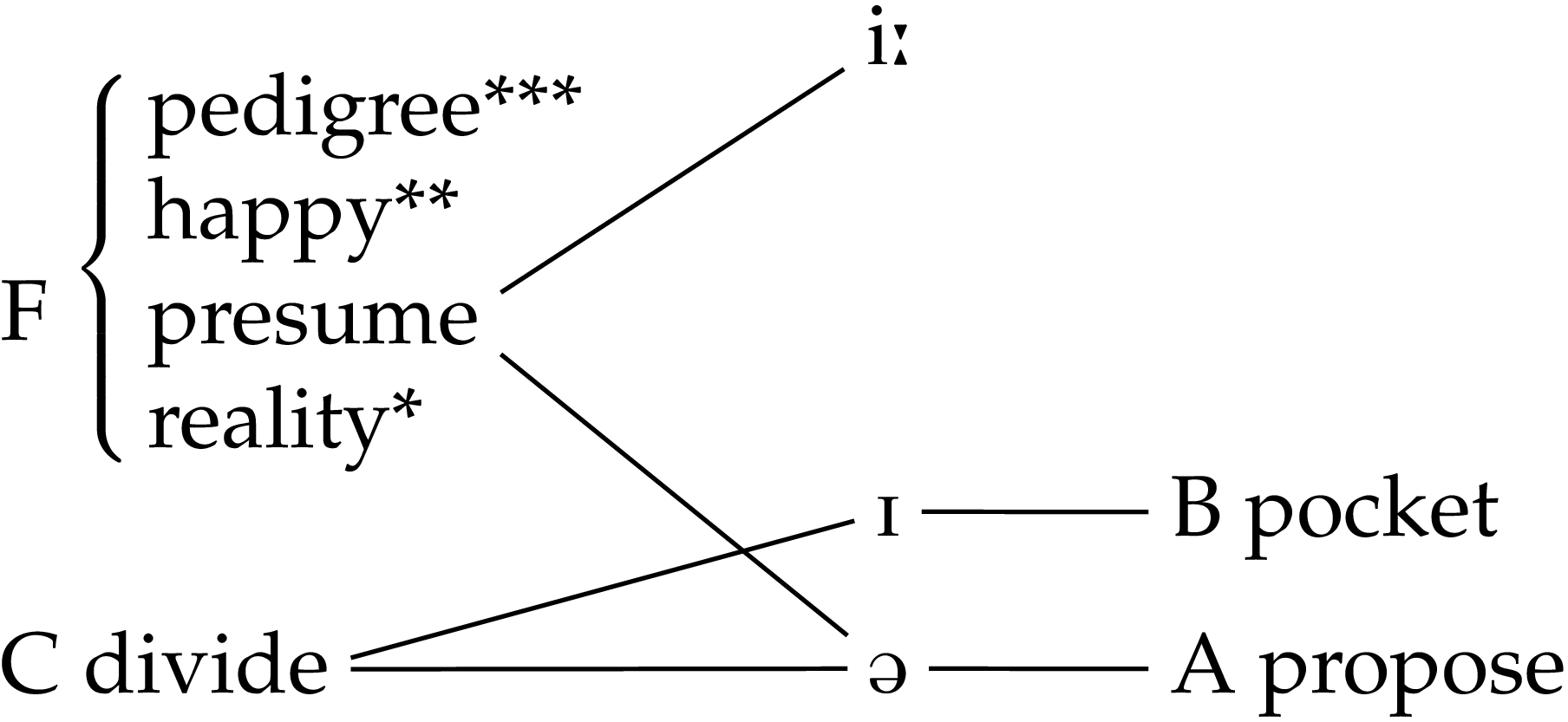
Type F, presume, is a real neutralization — not of /iː/ and /ɪ/, as Wells claims, but of /iː/ and /ə/. Type C, divide, is also a neutralization, this time of /ɪ/ and /ə/. Presume and divide must be lexically different, since divide never has /i/. This cannot be motivated by anything, so it must be lexically given (as it is indeed in LPD3). Divide and pocket must also be different, since pocket never has /ə/ in RP.
With the mapping rules listed above we produce the actual pronunciations of the following lexical forms shown in (19).
| lax ↔ tense | ||||||
|---|---|---|---|---|---|---|
| type | lex. | ə | ɪ | i | iː | |
| propose, variety, support | A | /ə/ | ||||
| pocket, -ing, -ed | B | /ɪ/ | ||||
| divide, select, pedigree, happily | C | |||||
| presume, release, December† reality, Seattle, preoccupy*† happy, happiness, polytechnic**† pedigree*** | F | /iː/ | ||||
| † | normally short because unstressed |
| * | does not become /ə/ because prevocalic |
| ** | does not become /ə/ because followed by # |
| *** | does not become /ə/ because stressed |
We have shown that there are four lexical types:
| type A, propose, | lexical /ə/, no variation |
| type B, pocket, | lexical /ɪ/, no variation |
| type C, divide, | lexical /ɪ/~/ə/ free variation |
| type F, presume, | lexical /iː/, with variants /i/~/ɪ/~/ə/ |
| (limited by rules) |
Pace Cruttenden, we cannot analyse happy/presume as phonemic /ɪ/ because then we would not be able to motivate the divergent behaviour of phonemic /ɪ/ in pocket or divide. Type F can only be phonemic /iː/. The really remarkable group is not type F but type C, divide, since its /ɪ/ never gets tensed to /i/ (just like type B, pocket), yet it may reduce to /ə/ (just like type F, presume). One may venture to predict that this group will sooner or later disappear, being absorbed into the other types.
I have argued that in current RP a restructuring of weak high front vowels has taken place, and presume/reality/happy/pedigree all have lexical /iː/. Pronouncing dictionaries may have pedagogical considerations (such as user-friendliness, over-explicitness), or follow their editorial traditions. Phonologically, however, /iː/ is the correct analysis for these weak syllables. If I am right, then presume-tensing does not exist as a phonological rule (any more than happy-tensing). Now presume is lexically /priː-/, reality is /riː-/, happy is /-piː/. The /ɪ/ variant in these words must now be produced by a rule of “presume-laxing”, which — in old-fashioned speech — optionally turns the weak-position /iː/ into /ɪ/, neutralizing it with lexical weak /ɪ/ in pocket, divide.
Fabricius, Anne. 2002. Weak vowels in modern RP: An acoustic study of happy-tensing and kit/schwa shift. Language Variation and Change 14: 211–237.
Cruttenden, Alan. 2001. Gimson’s pronunciation of English. 6th ed. London: Arnold.
Jones, Daniel. 1977. Everyman’s English Pronouncing Dictionary. Revised by A. C. Gimson, 14th ed. London: Dent. (= EPD14)
Jones, Daniel. 2006. Cambridge English Pronouncing Dictionary. Edited by Peter Roach, James Hartman, & Jane Setter. Cambridge University Press. (= EPD16)
Nádasdy, Ádám. 1994. Unstressed and partially-stressed syllables in English words. Unpublished PhD dissertation. Budapest: Hungarian Academy of Sciences.
Nádasdy, Ádám. 2006. Background to English pronunciation. Budapest: Tankönyvkiadó.
Trudgill, Peter. 2002. Sociolinguistic Variation and Change. Edinburgh: Edinburgh University Press.
Upton, Clive, W. A. Kretzschmar Jr., and Rafal Konopka. 2001. The Oxford Dictionary of Pronunciation for Current English. Oxford: Oxford University Press. (= ODP)
Wells, John C. 1982. Accents of English. Cambridge: Cambridge University Press.
Wells, John C. 2008 Longman Pronunciation Dictionary. 3rd ed. Harlow: Pearson Education. (= LPD3)
Wells, John C. 2012. happY again. John Wells’s Phonetic Blog. 7 June 2012. Retrieved on 2013-02-20 from phonetic-blog.blogspot.hu/2012/06/happy-again.html.
Windsor Lewis, Jack. 2003. IPA vowel symbols for British English in dictionaries. Journal of the International Phonetic Association 33/2: 143–152.
Windsor Lewis, Jack. 2009. Review of LPD3. Journal of the International Phonetic Association 39: 238–240.
This is a selection of data from LPD3. Note that there may be uncertainties (or downright mistakes) in the data. Examples for presume-tensing appear in boldface. The symbol /i/ automatically includes the possibility of lengthening to /iː/ and laxing to /ɪ/.
L = lax; T = tense
✓ = main pronunciation (bold type in LPD3)
X = alternative pronunciation (ordinary black type in LPD3)
x = second alternative pronunciation
0 = excluded by phonotactic constraint (in prevocalic position /ə/ is not permitted, so we find automatic happy-tensing)
*** = surprising, presumably erroneous data
% = the word exists with a different stressing (ignored here)
X1 = with primary stress
X2 = with secondary stress
| strong | weak | ||||||||
| L e | T iː | T i | L ɪ | ə | _CC | _V | _RV | remark | |
| BE- | |||||||||
| beatitude | ✓ | 0 | V | ||||||
| because | ✓ | X | |||||||
| believe | ✓ | X | |||||||
| bereave | ✓ | X | RV | ||||||
| beryllium | X | ✓ | RV | ||||||
| besmear | ✓ | X | .CC | # ? | |||||
| bestow | ✓ | X | .CC | ||||||
| bestrew | ✓ | X | .CC | ||||||
| between | ✓ | X | .CC | ||||||
| Beyoncé | ✓ | before /j/ | |||||||
| behind | ✓ | X | |||||||
| DE- | |||||||||
| debrís % | X | ||||||||
| decáde % | X | X | |||||||
| decathlon | X | ✓ | X | ? | |||||
| December | ✓ | X | |||||||
| decide | ✓ | X | |||||||
| decipher | X2 | ✓ | X | (#) | |||||
| decline (v) | ✓ | X | .CC | ||||||
| deconstruct | ✓2 | # | |||||||
| defect (v) | ✓ | X | |||||||
| degrade | ✓ | X | .CC | ||||||
| deontic | ✓ | 0 | V | ||||||
| derail | ✓2 | X | RV | # | |||||
| derange | ✓ | X | RV | ||||||
| derate | ✓2 | RV | # | ||||||
| deride/-sion/-sive | ✓ | X | RV | ||||||
| derisory*** | §X | ✓ | X | RV | error? | ||||
| derive | ✓ | X | RV | ||||||
| derogatory | ✓ | X | RV | ||||||
| destroy | ✓ | X | .CC | ||||||
| detáil % | X | X | |||||||
| determine/-er/-ate | ✓ | X | |||||||
| determinism*** | ✓ | X | error? | ||||||
| devour | ✓ | X | |||||||
| E- | |||||||||
| ecclesiastic | ✓ | X | .CC | ||||||
| egressive | ✓ | .CC | |||||||
| emancipate | ✓ | X | |||||||
| enamel | ✓ | X | |||||||
| enamour | X | ✓ | X | en#amour? | |||||
| enigma | X | ✓ | X | ||||||
| enormous | ✓ | X | |||||||
| enough | X | ✓ | |||||||
| enumerable | ✓ | X | |||||||
| enumerate*** | ✓ | X | error? | ||||||
| epenthesis | ✓ | X | X | ||||||
| epíscopal | X | ✓ | X | ||||||
| equalitarian | X | ✓ | X | .CC | |||||
| equality | ✓ | X | .CC | ||||||
| equanimous | X | ✓ | .CC | ? | |||||
| equatable | X | ✓ | X | .CC | |||||
| equate | ✓ | X | .CC | ||||||
| equestrian | X | ✓ | X | .CC | |||||
| equivalence/-t | ✓ | X | .CC | ||||||
| eradicate | ✓ | X | RV | ||||||
| erotic | ✓ | X | RV | ||||||
| erroneous | X | ✓ | X | RV | |||||
| escape | X | ✓ | X | .CC | |||||
| especial | X | ✓ | X | .CC | |||||
| evangelist | ✓ | X | |||||||
| event | ✓ | ||||||||
| evict/-ion | ✓ | ||||||||
| eviscerate | ✓ | X | |||||||
| evoke | ✓ | X | |||||||
| evólutive | X | ✓ | X | ||||||
| exuberant | X | ✓ | X | C.C | closed syl. | ||||
| PRE- | |||||||||
| preamble % | X1 | ✓ | 0 | V | |||||
| preclude | ✓ | X | .CC | ||||||
| pre-empt | X2 | ✓ | 0 | V | |||||
| prefer | ✓ | X | |||||||
| preliminary | ✓ | X | |||||||
| preoccupy | X2 | ✓ | 0 | V | |||||
| preordination | ✓2 | 0 | V | # | |||||
| prerequisite | ✓ | RV | (#) | ||||||
| prerogative | ✓ | X | RV | ||||||
| prescribe | ✓ | X | .CC | ||||||
| presidium | X | ✓ | X | ||||||
| prestigious | ✓ | X | X | .CC | prestige! | ||||
| presume | ✓ | X | |||||||
| RE- | |||||||||
| react | ✓ | 0 | V | ||||||
| reality | ✓ | 0 | V | ||||||
| re-enter | X2 | ✓ | 0 | V | # !! | ||||
| rejoice | ✓ | X | |||||||
| release | ✓ | X | |||||||
| reorder | ✓2 | 0 | V | # | |||||
| respond | ✓ | X | .CC | ||||||
| restrict | ✓ | X | .CC | ||||||
| SE- | |||||||||
| Seattle | ✓ | 0 | V | ||||||
| secede | ✓ | X | |||||||
| secretion | ✓ | X | .CC | ||||||
| secure | ✓ | X | |||||||
| select | X | ✓ | |||||||
| senility | X | ✓ | |||||||
| September | ✓ | X | X | C.C | closed syl. | ||||
| sequential | ✓ | X | .CC | ||||||
| serenity | X | ✓ | |||||||
| serology | X | ✓ | |||||||
| severe | ✓ | X | |||||||
Another selection of data from LPD3.
* with possible secondary stress
IPT = Initial-Pretonic Tensing
| strong | weak | ||||||||
| L | T | T | L | ə | _CC | _V | _RV | remark | |
| Spelling -I- | |||||||||
| identify | ✓ | X | x | IPT | |||||
| financial | ✓ | X | x | IPT | |||||
| dilate | ✓ | X | x | IPT | |||||
| dilapidate | ✓ | X | |||||||
| dilution | ✓* | X | x | IPT | |||||
| direction☞ | ✓ | x | X | RV | IPTIn pre-R position Wells uses a raised /ə/ to indicate the optional realization of Pre-R Breaking: /daɪəˈrekʃən/, etc. This is ignored here as it is irrelevant for the present discussion. | ||||
| Iranian | X | ✓ | RV | (IPT) | |||||
| tyrannical | x | ✓ | X | RV | (ipt) | ||||
| Italic | x | ✓ | X | (ipt) | |||||
| divide | ✓ | X | |||||||
| divine | ✓ | X | |||||||
| diffuse (a, v) | ✓ | X | |||||||
| dimension | ✓ | X | x | ||||||
| diminish | ✓ | X | |||||||
| digest (v) | ✓ | X | x | ||||||
| distract | ✓ | X | |||||||
| imagine | ✓ | ||||||||
| vitality | ✓ | < vital | |||||||
| virility | X | ✓ | RV | ||||||
| virology | ✓ | RV | < virus | ||||||
| Spelling -O- | |||||||||
| November | ✓ | X | IPT | ||||||
| omit | ✓ | X | IPT | ||||||
| donate | ✓ | X | IPT | ||||||
| profound | X | ✓ | (IPT) | ||||||
| romantic | X | ✓ | (IPT) | ||||||
| Spelling -A- | |||||||||
| vacation | ✓ | X | IPT | ||||||
| gradation | x | X | ✓ | (IPT) | |||||
| vacate | X | ✓ | (IPT) | ||||||
| gradate | ✓ | ||||||||
| catharsis | X | ✓ | |||||||
| facility | ✓ | ||||||||
| Spelling -E- | |||||||||
| pedantic | x | ✓ | X | ||||||
| periphery | x | X | ✓ | RV | |||||
| Jerome | x | X | ✓ | RV | |||||
| exalted | X | ✓ | x | C.C | closed syl. | ||||